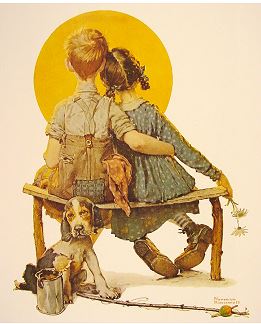Norman Rockwell (1894-1978) was an American asrtist most famous for his cover illustrations for The Saturday Evening Post. He contributed over 300 covers during a period of more than 40 years. This picture served as a propaganda poster in World War 2 and was used as the magazine's cover in May 1943. Women were encouraged to fill the jobs left vacant when the men went to war and Rosie was a kind of ideal. She became a feminist icon.
 |
| Norman Rockwell, Rosie The Riveter, 1943 |
Rockwell's model was a nineteen-year-old phone operator named Mary Doyle Keefe. She was a very petite young lady and said that Rockwell phoned her after the painting was completed to apologise for making her look so big. That was not an accident of course; the idea was to show that women could be strong and easily do men's jobs. The picture has iconic status in the United States and was sold to a museum for $5 million in 2002. Rosie is seen eating a ham sandwich with a huge (light-weight fake) riveting gun on her lap. She has her foot placed, symbolically, on a copy of Hitler's Mein Kampf. The picture was sent on a touring exhibition to encourage people to buy war bonds along with a set of four pictures called Freedom of Worship, Freedom from Fear, Freedom from Want and Freedom of Speech.
 |
| The Four Freedoms |
Rockwell has often been dismissed as a proper artist largely because of the perceived "cartoonish" sentimentality of his subjects. Critics would say that he is an illustrator rather than an artist. He had no problem with that and even referred to himself as an illustrator. However, I think he is hard done by. His paintings show obvious great skill and technique with superb compositions. His work was not always sentimental. Consider the picture below.
 |
| Norman Rockwell, The Problem We All Live With, 1964 |
This a very serious picture. The little girl is being escorted into a school in the south by US Marshalls. They are headless and the girl is highlighted to make sure that she captures your attention. Rockwell made her dress white (it was dark grey in reality) so that it formed a high contrast with her dark skin. The rest of the picture is fairly 'grey' with the shocking exception of the rotten tomatoes that have been thrown and the yellow armbands. Also the whole picture forms a golden rectangle as does the ratio, top left from her chest. None of this is accidental, including the way she appears the be 'boxed-in' by the marshals.
On a lighter note, much of the imagery in the film Forrest Gump is based on Rockwell's work.
And finally a look at a very typical and much reproduced early work:
 |
| Rockwell Young Forrest Gump |
 |
| Gazing at the Moon, 1926
I am listening to Betty Wright's Clean Up Woman. A brilliant 70s soul recording with fabulous guitar playing by Willie "Little Beaver" Hale.
|









